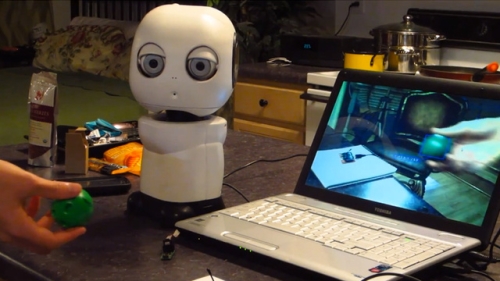Sure the 3D printer you have at home can't print pizza the way NASA's soon will, but at least it can print the parts essential for building your own robot and that goes a long way for creating something out of nothing.
MAKI, the emotive robot
For the price of a sushi dinner, you can build your own MAKI robot. Simply replicate the parts using a 3D printer and purchase the necessary electronics from an over-the-counter hobby store. MAKI is a low-cost solution for hobbyists and software programmers to develop their own interactive software to advance the HRI ( human-robot interaction) body of knowledge.

MAKI can be printed on printers with a build envelope of at least 150 x 150 x 140 mm. Since the robot is open source and modular, you decide the robot's function, thereby printing and purchasing only those specific components required for your design. By default, MAKI has an embedded USB microphone and webcam and can be used for complex actions like vision processing, with the help of software like RoboRealm or Open CV, or as just an animatronic head.
InMoov is fully human sized
French inventor Gael Langevin ups the ante even further with a human-sized 3D-printed robot, the InMoov. Langevin's design sheets are free and publicly available, provided you can afford the plastic filament needed to reproduce all the components. Note the project is an ongoing endeavor; Langevin has completed the head down through the shoulders, arms, and hands, but the rest of the body is in development.

InMoov started as just a hand, and has become a nearly complete upper body.
The robot operates using voice command and gesture capture, courtesy of the MyRobotLab software coupled with an Arduino CPU. Currently, InMoov's arms can hold a ball and pass it between its hands, raise it themselves above the robot's head, and perform various sweeping motions. Movement is initiated by motors and electronics obtainable from hobby stores.
The Inchworm robot
This particular breed of 3D printed robot comes straight from Bizarro World – it's self-assembling.

A collaborative effort between Harvard and MIT based researchers resulted in a robot that transforms itself from a 3D printed, flat two-dimensional surface into a wormlike robot using shape memory polymers that automatically fold into a specific shape; the only outside intervention is the attachment of the motor and batteries.
Harvard graduate student Sam Felton states that the goal of this project was to create robots as quickly and inexpensively as possible, but bigger things are in store for the future: “Currently the goal is to just make a more complicated robot, and one that can fold itself and then walk away,” Felton says.
Visit TechXchange to share and discuss your 3D printable projects.
Advertisement
Learn more about Digi-Key





